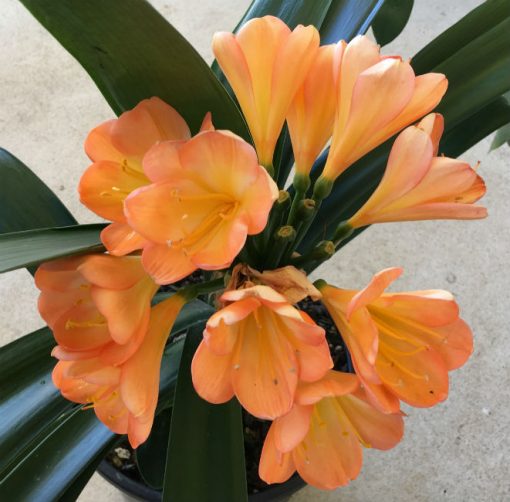different colors of clivia
Clivia plants are a treasure for gardeners. There are several colors and some of them even have different colors. Since it can be very expensive, many growers decide to start them from seed. Unfortunately, it can take years for the plant to bloom because it needs five leaves. Genetically identical seeds that generally differ in color from their parent plant. In addition, dominant colors have the power to change the final color of a strain. Clivia plants also change with age and most of them get different colors. Therefore, here you will get to know the different colors of Clivia.
The reasons for the different colors of clivia
Clivias with the same parent may have different bloom colors due to genetic variation, cross-pollination, or prevailing color. Clivia plants undergo color changes both during their early growth and as they mature. It is possible for offsets to bloom with a slightly different shade than their parent plants. While this Clivia color shift adds to the plants’ allure, it irritates real collectors.
Clivia Color Change from Seed
Color inheritance is fickle in Clivia. They follow the basic genetic cross rules with a seed getting DNA from each plant that contributed pollen. However, there are some traits that are not passed on, and others that are dominant and crowd out the expected trait.
For instance, if a yellow crosses with an orange, its DNA will mingle. If the yellow had two yellow genes and the orange had two orange genes, the flower color will be orange. If you take this orange plant and cross it with two yellow genes, the flowers will be yellow because that orange had one yellow and one orange gene. Yellow wins.
Clivia Flower Colors in Young Plants
An offset is a genetic clone of the parent, so you should expect the same color flower. However, young offsets will have a slightly different tint and characteristics for the first year they flower. Seed planted Clivia have many variables that relate to color and even true seeds of the same species may take a few years to produce the same shade as the parent. Other factors that make Clivia plants turn color are environmental and cultural. They need indirect light and weekly watering in spring and summer. In fall and winter, gradually reduce water and move the plant to a cooler room of the house. Excess or dim light will inform bloom color, as will too much or too little water.
Do you know the tips of “Clivia plant care“?
Tips for Clivia Flower Colors
Different flower color in Clivias is to be expected even in controlled growing situations. Nature is tricky and often sneaks in some surprises. You can tell the color of the plant from the stem color well before it begins to bloom.
Purplish stems indicate a bronze or orange bloom, while green stems usually indicate yellows. Other pastel colors can be harder to pinpoint, as they may have a greenish stem or a darkly colored one. It depends upon the exact cross of the plant, and if you don’t know that, you can expect changing Clivia colors. Unless you are growing to sell the plants, Clivia in any color is a satisfying winter blooming houseplant that will brighten up the dark gloom of the cold season.
Clivia Miniata Color Mutations and their Breeding
The author discusses the process of color inheritance in Clivia, a plant species. They believe that for a particular color mutation to be inherited through sexual reproduction, a pathway must occur, where genes or other factors influencing the color must align. They suggest viewing chromosomes and loci on which these chromosomes have mutated by placing two rulers side by side, representing different plants with similar color mutations. Only if both plants have mutated on the same point of the chromosomes (rulers) would the mutation be transferred to the offspring by sexual reproduction.
Plants are easy to line breed or inbreed due to their self-pollination, but mechanisms in plants inhibit self-pollination, making it more challenging to perpetuate color mutations. The best-known color mutation in Clivia is the yellow mutation in Clivia miniata. However, just because two plants are yellow doesn’t necessarily mean they have mutated at the same loci on the chromosome.
Bill Morris classified yellow mutations into Group 1 and Group 2 yellows, producing homozygous offspring within their group but reverting to orange when bred across them. These groups have mutated different points on chromosomes, making them very similar but genetically different. Yellow flowering Clivia miniata mutations should not be presumed to belong to one group or another, as many groups exist. Controlled breeding with known groups is necessary before classification. 99% of yellow miniata worldwide would belong to Group 1, with 0.9%+ Group 2 yellow and 0.1%+ numerous other groups.
Examples of these groups are:
The author discusses the breeding program for a group of yellow flowering plants, specifically Group 3 and the Alpha Group. Group 3 is where plants display yellow flowers but develop red berries and maroon stem pigmentation in both seedlings and adult plants. The author is still working to classify which and how many clones belong to this group.
The Alpha Group consists of plants that have mutated on the same point as Ndwedwe Alpha, a wild collected clone. All known plants in this group are direct descendents of Ndwedwe Alpha, leading to unpigmented seedlings and resulting yellow flowering plants. However, even wild collected yellow plants from the same area do not necessarily belong to the same group.
To classify unknown yellow flowering plants with unknown genealogy, the author self-pollinates the plant and uses its pollen onto known groups of plants, such as Group 1 and Group 2. The results of these crosses guide the breeding program in the direction of perpetuating the color mutation. Self-seedlings flowering the same as the parent should be selected and the breeding programme continued.
Not all naturally occurring clones of any group are worth perpetuating in numbers, as they may be inferior to existing yellow clones and hybrids available. For example, Ndwedwe Alpha is a speculator and is a first-class plant, so the “Alpha group” line breeding is being continued to attempt to perpetuate the excellent qualities in Ndwedwe Alpha.
Clivia Miniata color mutations occur naturally in clivia populations, including Peach, Pink, Apricot, Bicolor, Pictees, and more. The author’s approach to these mutations involves self-pollinating them and crossing them with as many similarly colored plants as possible, hoping that some may have mutated on the same loci on the chromosome, resulting in seedlings with similar colors to the original parents.
An example of successful line breeding
Over the past nine years, the author has been working with the plant “Emmie Wittig Pink,” described as the clearest and truest pink. The plant has delicate pink flowers, maroon berries, and an offspring that reverts to orange. The author first acquired the plant in 1996 and self-pollinated it, crossing it with other known groups of yellow mutation clivia Miniata. The best orange seedlings were selected and Emmie Wittig Pink was used as a pollen parent. The resulting offspring produced 1/3 unpigmented, 1/3 lightly pigmented, and 1/3 heavily pigmented seedlings. All unpigmented seedlings produced pink flowering plants, while pigmented seedlings dark and light produced normal orange flowering plants. The Pink offspring were then crossed back to their mother and siblings, resulting in all unpigmented seedlings flowering pink.
Using line breeding as a tool, the author emphasizes the importance of carefully selecting seedlings and keeping good records to avoid loss of vigor and other recessive undesirable genes. Breeding plenty and selecting only the best for further breeding can lead to quicker desired results. The author first used line breeding/inbreeding to produce their Chubb Peach line and has since used it in many other lines with good results.
Picotees and bi colors
Bicolor is a two-colored tepal with a throat color ranging from 50% to 90% of the tepal length, while a single-color throat combines yellow and white. A picotee is a rim of color less than 10% of the tepal length on the distal or outer end of the tepal, with a clear demarcation between the outer rim and the throat color.
Picotees and bricoleurs fall under the same type of coloring, with true picotees having only 10% of color around the rim of the petals. Carrie’s Picotee has been used in breeding programs, with results ranging from bicolor to very good picotee types. A new line is being developed with thin Pencil line picotees, which are short leaf, compact plants used to shorten leaves and make plants more squat.
Line breeding is important for selecting seedlings carefully and keeping good records to avoid loss of vigor and other recessive undesirable genes. Breeding plenty and selecting only the best for further breeding can lead to quicker desired results.
Using line breeding/inbreeding to produce true breeding Chubb Peach plants has been successful in many other lines, and it is possible to reproduce any clivia miniata mutation or color form within 5-9 years.













